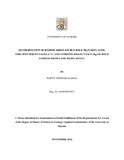| dc.description.abstract | Lamu Basin in south eastern Kenya rests on a passively developed margin of the African plate. The Basin hosts thick sediments that are dominantly shale, sands and limestones, that overlie the Neoproterozoic metamorphic rocks of the Mozambique Belt. This research aims at determining the suitability of using smectite percentages in illite/smectite mixed layer clay minerals to identify the depth below the earth surface of hydrocarbons generation from the source rocks. The clay minerals present in Lamu Basin’s rock formation were also identified with the depth and rock formation of their occurrence identified. Since 1960, sixteen petroleum exploratory wells have been drilled, though no commercial hydrocarbon deposits have been documented. Moreso, the older wells in Basin such as Walu, Kipini and Hagarso were not subjected to thorough evaluation of their hydrocarbon potential at the period of drilling. The maturity of Lamu Basin source rocks has previously been done using vitrinite reflectance, a technique that requires a rock to have vitrinite maceral component. The maceral component is a hydrocarbon compound whose light reflectance increases with maturity, that is, increase in temperature. Smectite to illite transformation has been used in tracing increase in temperature with increase in depth in sedimentary basins. For this research, forty eight (48) drilled core samples from Kipini-1, Simba-1, Walu-1, Walu-2 and Maridadi-1B wells which were drilled in the years between 1963-1987 in Lamu Basin were obtained on 15th and 16th October, 2015 from National Oil Corporation of Kenya (NOCK). The forty eight samples were analysed using X-ray diffraction clay mineral analysis three weeks later at KENGEN company laboratories at Naivasha, Kenya. In Simba-1 the illite/smectite mineral occurs at 1585-1590m with 85% smectite and at 1840-1845m with 29% smectite both from Kipini formation and at burial temperatures of 65-70 ͦ C. In Walu-2 well the illite/smectite mineral occurs at 1410-1411m with 55% smectite from Barren Bed Formation and at burial temperatures of 65-80 ͦ C. According to vitrinite reflectance analysis, Simba-1 hydrocarbon maturity zone is at 3050m to total depth of 3569m with vitrinite reflectance of 0.6-0.85%. Occurrence of illite/smectite mixed layer coincides with hydrocarbon source rock immature depths as indicated by vitrinite reflectance data. However, more detailed sampling should be done in the four wells and other wells in the Basin for a comparative analysis. | en_US |



